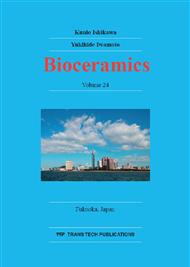[1]
T. Leventouri, C.E. Bunaciu, V. Perdikatsis, Neutron powder diffraction studies of silicon-substituted hydroxyapatite, Biomaterials. 24 (2003) 4205-4211.
DOI: 10.1016/s0142-9612(03)00333-8
Google Scholar
[2]
I.R. Gibson, S.M. Best, W. Bonfield, Chemical characterization of silicon-substituted hydroxyapatite, J. Biomed. Mater. Res. 44 (1999) 422-428.
DOI: 10.1002/(sici)1097-4636(19990315)44:4<422::aid-jbm8>3.0.co;2-#
Google Scholar
[3]
E.S. Thian, J. Huang, S.M. Best, Z.H. Barber, W. Bonfield, Magnetron co-sputtered silicon-containing hydroxyapatite thin films—an in vitro study, Biomaterials. 26 (2005) 2947-2956.
DOI: 10.1016/j.biomaterials.2004.07.058
Google Scholar
[4]
A. Aminian, M. Solati-Hashjin, A. Samadikuchaksaraei, F. Bakhshi, F. Gorjipour, A. Farzadi, F. Moztarzadeh, M. Schmücker, Synthesis of silicon-substituted hydroxyapatite by a hydrothermal method with two different phosphorous sources, Ceram. Int. 37 (2011).
DOI: 10.1016/j.ceramint.2010.11.044
Google Scholar
[5]
K.A. Hing, P.A. Revell, N. Smith, T. Buckland, Effect of silicon level on rate, quality and progression of bone healing within silicate-substituted porous hydroxyapatite scaffolds, Biomaterials. 27 (2006) 5014-5026.
DOI: 10.1016/j.biomaterials.2006.05.039
Google Scholar
[6]
A.E. Porter, N. Patel, J.N. Skepper, S.M. Best, W. Bonfield, Comparison of in vivo dissolution processes in hydroxyapatite and silicon-substituted hydroxyapatite bioceramics, Biomaterials. 24 (2003) 4609-4620.
DOI: 10.1016/s0142-9612(03)00355-7
Google Scholar
[7]
S. Koutsopoulos, Synthesis and characterization of hydroxyapatite crystals: A review study on the analytical methods, J. Biomed. Mater. Res. 62 (2002) 600-612.
DOI: 10.1002/jbm.10280
Google Scholar
[8]
M. Markovic, B.O. Fowler, M.S. Tung, Preparation and Comprehensive Characterization of a Calcium Hydroxyapatite Reference Material, J. Res. Natl. Inst. Stand. Technol. 109 (2004) 553-568.
DOI: 10.6028/jres.109.042
Google Scholar
[9]
A. Antonakos, E. Liarokapis, T. Leventouri, Micro-Raman and FTIR studies of synthetic and natural apatites, Biomaterials. 28 (2007) 3043-3054.
DOI: 10.1016/j.biomaterials.2007.02.028
Google Scholar
[10]
S. Zou, J. Huang, S. Best, W. Bonfield, Crystal imperfection studies of pure and silicon substituted hydroxyapatite using Raman and XRD, J. Mater. Sci. Mater. Med. 16 (2005) 1143-1148.
DOI: 10.1007/s10856-005-4721-8
Google Scholar
[11]
K. Fukumi, J. Hayakawa, T. Komiyama, Intensity of Raman Band in Silicate Glasses, J. Non-Cryst. Solids. 119 (1990) 297-302.
DOI: 10.1016/0022-3093(90)90302-3
Google Scholar
[12]
P. McMillan, Structural studies of silicate glasses and melts-applications and limitations of Raman spectroscopy, Am. Min. 69 (1984) 622-644.
Google Scholar


